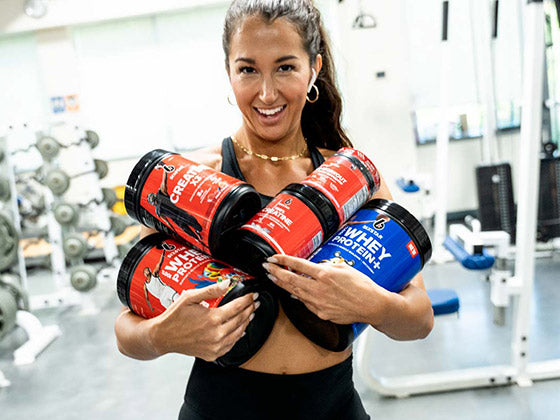Creatine is a popular supplement that many people use to boost their workout performance. It is particularly effective for high-intensity activities like weight lifting since it helps provide your muscles with the energy they need for those quick bursts of effort.
Not only can it assist in boosting muscle strength and aiding in muscle growth, but it also plays a role in preventing muscle loss and speeding up recovery from injuries. That is why many athletes decide to consume creatine to achieve the best results for their bodies.
However, to truly maximize the benefits of creatine, it is essential to take the correct amount at the optimal times. With that said, you might be wondering how much creatine I should take.
With proper creatine dosage, you will notice significant improvements in your exercise performance and strength gains. In other words, integrating creatine thoughtfully into your regimen can be a game-changer for achieving your fitness goals!
Table of contents
Creatine Sources
Before you decide to take creatine, you need to understand how much of it you need and where you can find it. Namely, creatine is not solely found in supplement forms. Considering it is a natural compound, you can also find it in food.
So, when it comes to naturally occurring creatine, you will find it mainly in foods like meat, fish, and cow's milk. However, there is no solid evidence to suggest that eating more of these foods provides significant advantages for athletic performance, especially when you can get similar protein levels from other sources.
The most popular and well-researched form of creatine is creatine monohydrate. Other types you might come across do not really offer any additional benefits, so it is best to stick with what is tried and true.
Nonetheless, you can always strike a balance and include creatine supplementation along with eating foods that contain creatine. This way, you will know that you are taking supplements in a healthy manner and moving forward towards your goals!
Creatine Dosage
Creatine is a substance that your muscles store, and while your body makes some on its own, you can also get it from foods like meat and fish.
If you eat a regular omnivorous diet, you’re probably getting around 1 to 2 grams of creatine daily, but even then, your muscles might only be about 60% to 80% of their full capacity. To really boost those muscle stores, many people, especially athletes, turn to creatine supplements.
When starting out, many trainers suggest doing a "loading phase." This means taking a higher dose of creatine for a short time to quickly fill up your muscles.
A common method is to take about 20 to 25 grams each day for 5 to 7 days, usually split into four or five servings throughout the day. After that, you can just keep your daily creatine intake of 3 to 5 grams.
Loading vs. Maintenance Creatine Dosage
To better understand how much creatine I should take, it is essential to know that there are two ways to consume this supplement. When you figure out these approaches, you will know exactly what you need and what will work for you.
So, the first one is the loading strategy, where you kick things off with a higher dose to fill your body’s creatine stores quickly. This means that you would take around 20 to 25 grams per day, which is about 0.3 grams for every kilogram of your body weight, for about 5 to 7 days.
It is often split into smaller doses throughout the day, like every four hours. After this initial phase, you would drop down to a maintenance dose of about 3 to 5 grams daily.
The second option is the maintenance strategy, where you skip the loading phase altogether and simply keep up your daily creatine intake of 3 to 5 grams for four weeks. This method leads to a slower buildup of creatine in your system, which might be preferable for some people.
When deciding how to take creatine, you should know that the choice between these two methods depends on what you are looking to achieve.
If you are eager to see results in a short time, the loading strategy could be the way to go. However, if you are concerned about potential weight gain that can come from those larger initial doses, sticking with the maintenance strategy might be a better fit for you.
Factors That Influence Creatine Dosage
When it comes to how much creatine I should take, it can really vary based on several factors. For example, your age, body size, gender, the goals you have for your training, and how intense your workouts are all play a role. In other words, it is not only the goal you want to achieve with it.
People who do high-intensity workouts or strength training often see the most benefits from creatine. Considering there are plenty of benefits of creatine for athletes, this is understandable.
However, if you are unsure about what dosage would be best for you, it is a good idea to chat with a healthcare provider. They can help you figure out a tailored creatine plan that fits your individual needs and supports your fitness goals.
Plus, getting personalized advice can be really helpful in maximizing your results!
How to Take Creatine?
Creatine comes in several forms, like powder, capsules, or gummies, and it is important to take it with plenty of water since it pulls water into your muscles, which can make you thirstier. You can mix it into your pre-workout drinks or smoothies, too.
The amount of creatine you should take really depends on your fitness goals and health needs. If you are not doing high-intensity workouts, you probably will not need the loading dose strategy. Just 3 to 5 grams a day is usually sufficient for health benefits with minimal side effects. For the best results, it is key to take creatine consistently, ideally for more than two weeks.
Research suggests that taking creatine alongside carbs (like 94 grams of carbs plus 5 grams of creatine) or a mix of carbs and protein (47 grams of carbs, 50 grams of protein, and 5 grams of creatine) can help your muscles store and retain creatine better.
When to take creatine is a hot topic, but for those looking to hit their fitness targets, taking it right before or after your workout seems to be the way to go!
Monitoring Creatine Intake
Research indicates that taking creatine can boost your strength, increase muscle mass, and enhance your endurance during workouts. In simpler terms, many people find that their physical performance gets a noticeable upgrade when they start using creatine.
However, it is worth noting that it might take anywhere from about a week to several weeks before you start seeing the benefits of creatine. How quickly it kicks in can depend on how much you are taking and when.
If you find that your performance is not improving after some time on creatine, it could be a sign that you need to tweak your dosage. So, do not hesitate to adjust it to see if it makes a difference!
But make sure that you never cross the line of safety. In other words, always be careful with the dosage and the recommendations. When we mention tweaking of dosage, we do not mean you should double or triple it, but rather a little adjustment.
Safety Considerations While Taking Creatine
Creatine is generally viewed as a safe supplement for most people, but like anything, it can have its downsides. Some users might experience side effects such as dehydration, upset stomach, or muscle cramps.
It should be noted that earlier concerns about creatine causing water retention have been addressed in several studies, which actually show that it does not lead to significant water retention at all.
To minimize the chances of experiencing any negative effects, the best approach is to follow the recommended creatine dosage and avoid taking more than you should. Always listen to your body and talk to a healthcare provider if you have any questions or concerns about starting creatine or any supplement.
This does not only refer to creatine but to every other supplement you intend to take. So, whether it is creatine or protein, ensure that you are on the same side with the guidelines.
Creatine Types
Before you decide to consume creatine, you need to know what types are out there. This is important, so you know that you have chosen the right thing for your goals.
1. Creatine Monohydrate
Creatine monohydrate is by far the most popular and researched type of creatine out there. It is known to be about 88% creatine by weight, which is pretty impressive, and the body absorbs it quite effectively - almost completely!
Plus, one of the best parts is that it is usually more budget-friendly compared to other forms of creatine, making it easy to find in stores or online. So if you are considering adding creatine to your diet and daily habits, this one is definitely worth looking into!
2. Other Creatine Types
Besides creatine monohydrate, this compound has several other types as well -each with its own unique characteristics.
For instance, creatine citrate combines creatine with citric acid, which is thought to enhance its solubility and absorption. However, despite its marketed benefits, studies suggest that it does not necessarily outperform the classic creatine monohydrate when it comes to bioavailability.
On the other hand, there is creatine nitrate, which is newer and has attracted attention because nitrates can boost exercise performance. Yet, research indicates that when equal doses of creatine monohydrate and creatine nitrate are compared, they show similar effects on performance.
Then we have creatine ethyl ester and creatine hydrochloride. Creatine ethyl ester was created in hopes of offering better absorption, but the evidence supporting its superiority over monohydrate is sparse.
Creatine hydrochloride has shown some promise in terms of absorption, but it is also more expensive and offers no significant advantages in fitness benefits compared to monohydrate.
Lastly, creatine magnesium chelate might help reduce the water retention common with creatine use, but again, there is no strong evidence that it outperforms other types. All in all, while each form has its proponents, creatine monohydrate remains the go-to option for many athletes.
What Form of Creatine Should You Use?
As we mentioned before, you can consume creatine in the form of powder, pills, or liquid. The decision really comes down to what you prefer.
For instance, creatine powder tends to give you better value and absorbs into your system more quickly, while pills are super convenient. Both types are effective for reaching your fitness goals, but powder gives you more control over how much you take and is generally cheaper.
On the other hand, pills are ready to go and easy to carry, but they can be pricier, and you often need to take multiple pills to hit the right dose.
As for creatine liquid, this form is often absorbed by your body quite well, especially when made from dissolved powder. That said, liquid creatine can be pricier and might be a bit trickier to transport than pills. It is ideal for those who prefer taking their supplements in liquid form or anyone who has trouble swallowing pills.
Six Star Creatine supplements are created with different people and preferences in mind. So, you can choose the form you prefer, and never miss a day of taking your supplement. If you are serious about your goals, skipping creatine for athletes is not an option.
Over to You
As you can see, creatine is a great supplement that can really enhance your energy levels during workouts, leading to increased muscle growth, improved performance, and better athletic capacity. And, making sure you take the right dosage will help you achieve your goals faster!



